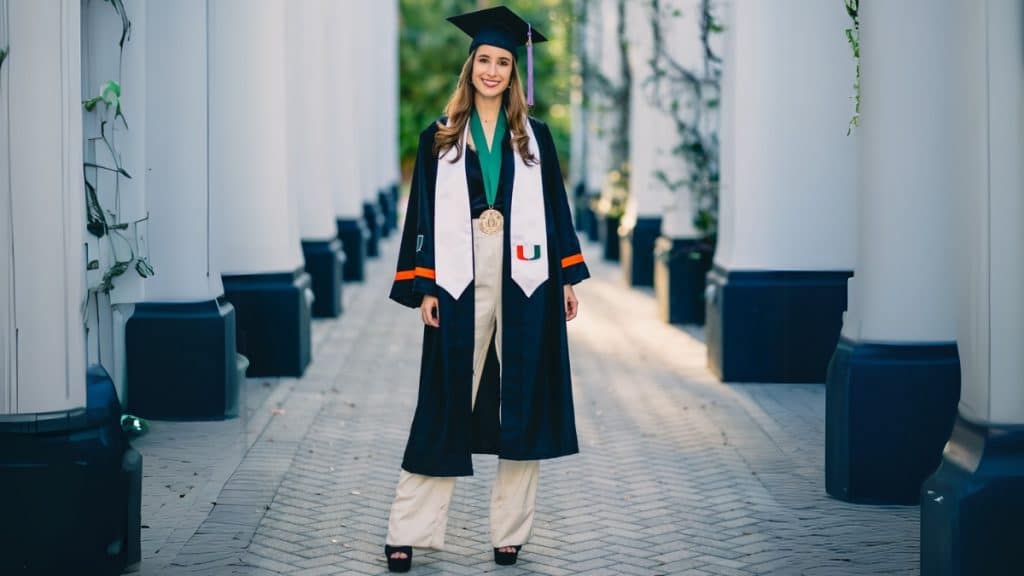Larah Garcez Biondo, a Brazilian-Italian architect and lead interior designer, exemplified both academic excellence and a commitment to community-driven design during her time at the University of Miami. Her architectural journey was anything but linear, reflecting a combination of her passions for numbers and creativity. Initially entering the University of Miami as an architectural engineering major, Larah soon realized her true calling was architecture, where she could merge her love for technical precision with her creative instincts. This pivotal decision set the stage for her to become a key figure in the university’s architecture program, culminating in her recognition for an award-winning project that would leave a lasting impact on the community.
One of Larah’s most significant contributions was her work on the Marsh Harbour Resiliency Center, a project developed in the aftermath of Hurricane Dorian in 2019. This devastating hurricane prompted the University of Miami to challenge its architecture students to design a resiliency center for Marsh Harbour in the Bahamas. The project’s goal was to create a multifunctional space that could serve as a community hub during normal conditions but transform into a fully functional hurricane shelter during emergencies.
Larah, along with her teammate, tackled this challenge with determination and creativity. Their design featured innovative elements such as movable retractable walls, Murphy beds integrated into the walls, and louvered systems that allowed portions of the building to open or close depending on the weather conditions. The louvered systems allowed for breezes and sunlight to filter into the building during calm weather, while sealing the building for protection during a hurricane. Larah’s focus on practicality and real-world application set her project apart. She and her partner designed a building that was not only visually striking but also incredibly functional, reflecting their deep understanding of the needs of the Bahamian community. They incorporated solar panels and water storage systems to ensure the center’s self-sufficiency, even in times of crisis
The Resiliency Center project, which was built as part of Larah’s Architecture Studio Design class, presented additional challenges because it required integration with the Building Technologies course. Larah had to incorporate technical components such as HVAC, plumbing, electrical, and solar analysis plans into the design, a complex task that most students had not encountered before. This combination of creative design and technical expertise earned Larah and her team the award for Best Project of the Semester. The project was also featured in an article by the University of Miami, highlighting the innovative solutions proposed by Larah.
Larah’s project stood out not only for its architectural merit but also for its social and community impact. The project was designed to be a versatile space that could host everything from yoga classes and after-school programs to fish markets and basketball games, making it a vital part of daily life in the community. During a hurricane, the center would transform into a protective fortress, housing residents safely within its walls. This adaptability was a key element of Larah’s design philosophy: creating beautiful spaces that also serve functional, practical needs.
Larah’s recognition for the Resiliency Center project marked a significant moment in her academic journey, reinforcing her belief that architecture is not just about aesthetics but about solving real-world problems. The award validated her dedication to combining creativity with functionality and showed that even the most challenging circumstances, like the COVID-19 pandemic during which the project was completed, could not stop her from delivering exceptional work. Her ability to lead, solve complex problems, and deliver innovative designs has carried over into her professional career as an architect and lead interior designer at Design Solutions, where she continues to take on complex projects and push the boundaries of design.
Looking back at her time at the University of Miami, Larah reflects on how her academic experiences have shaped her approach to architecture and community involvement. Her project for the Marsh Harbour Resiliency Center demonstrated not only her technical abilities but also her commitment to creating spaces that respond to the needs of the people they serve. Larah’s future projects will undoubtedly continue to reflect this passion for thoughtful, community-focused design.
Find more information at:
https://news.miami.edu/stories/2020/05/students-unveil-their-visions-of-a-resiliency-
center-for-bahamas-town.html.
